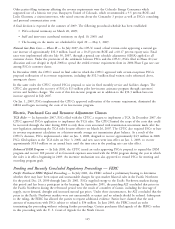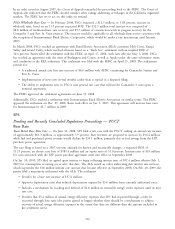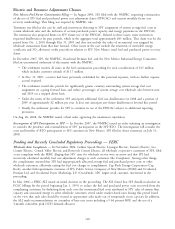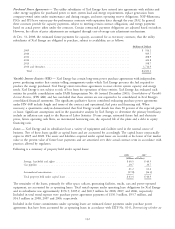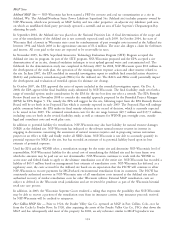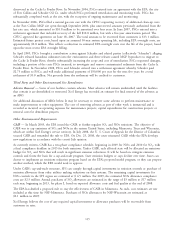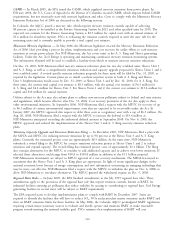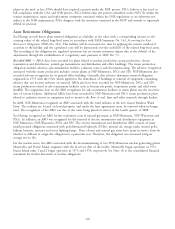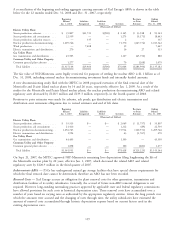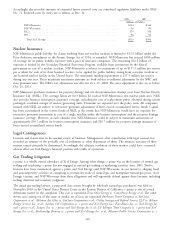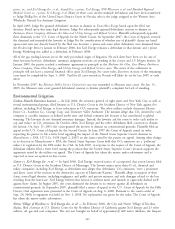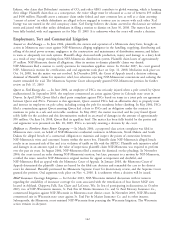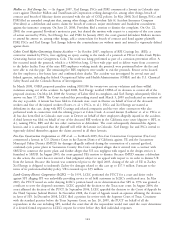Xcel Energy 2008 Annual Report Download - page 144
Download and view the complete annual report
Please find page 144 of the 2008 Xcel Energy annual report below. You can navigate through the pages in the report by either clicking on the pages listed below, or by using the keyword search tool below to find specific information within the annual report.MGP Sites
Ashland MGP Site — NSP-Wisconsin has been named a PRP for creosote and coal tar contamination at a site in
Ashland, Wis. The Ashland/Northern States Power Lakefront Superfund Site (Ashland site) includes property owned by
NSP-Wisconsin, which was previously an MGP facility and two other properties: an adjacent city lakeshore park area,
on which an unaffiliated third party previously operated a sawmill, and an area of Lake Superior’s Chequamegon Bay
adjoining the park.
In September 2002, the Ashland site was placed on the National Priorities List. A final determination of the scope and
cost of the remediation of the Ashland site is not currently expected until early 2009. In October 2004, the state of
Wisconsin filed a lawsuit in Wisconsin state court for reimbursement of past oversight costs incurred at the Ashland site
between 1994 and March 2003 in the approximate amount of $1.4 million. The state also alleges a claim for forfeitures
and interest. All costs paid to the state are expected to be recoverable in rates.
In November 2005, the EPA Superfund Innovative Technology Evaluation Program (SITE) Program accepted the
Ashland site into its program. As part of the SITE program, NSP-Wisconsin proposed and the EPA accepted a site
demonstration of an in situ, chemical oxidation technique to treat upland ground water and contaminated soil. The
fieldwork for the demonstration study was completed in February 2007. In 2008, NSP-Wisconsin spent $0.8 million in
the development of the work plan, the operation of the existing interim response action and other matters related to
the site. In June 2007, the EPA modified its remedial investigation report to establish final remedial action objectives
(RAOs) and preliminary remediation goals (PRGs) for the Ashland site. The RAOs and PRGs could potentially impact
the development and evaluation of remedial options for ultimate site cleanup.
In October 2007, the EPA approved the series of reports included in the remedial investigation report. On Dec. 4,
2008, the EPA approved the final feasibility study submitted by NSP-Wisconsin. The final feasibility study sets forth a
range of remedial options under consideration by the EPA for the site but does not select a remedy. The EPA Remedy
Review Board met in November 2008 to consider the remedial approach proposed by the Remedial Project Manager
(RPM) for EPA Region 5. The remedy the EPA will suggest for the site, following input from the EPA Remedy Review
Board, will be set forth in its Proposed Plan which is currently expected in early 2009. The Proposed Plan will undergo
public comment before the EPA makes its final remedy selection in its record of decision, which is currently expected
to be issued in late 2009. The estimated remediation costs for the site range between $49.7 million and $137.5 million,
including costs set forth in the revised feasibility study, as well as estimates for WDNR past oversight costs, outside
legal and consultant costs and work plan costs.
In addition to potential liability for remediation, NSP-Wisconsin may also have liability for natural resource damages
(NRD) at the Ashland site. NSP-Wisconsin has indicated to the relevant natural resource trustees its interest in
engaging in discussions concerning the assessment of natural resources injuries and in proposing various restoration
projects in an effort to fully and finally resolve all NRD claims. NSP-Wisconsin is not able to accurately quantify its
potential exposure for NRD at the site, but has recorded an estimate of its potential liability based upon its best
estimate of potential exposure.
Until the EPA and the WDNR select a remediation strategy for the entire site and determine NSP-Wisconsin’s level of
responsibility, NSP-Wisconsin’s liability for the actual cost of remediating the Ashland site and the time frame over
which the amounts may be paid out are not determinable. NSP-Wisconsin continues to work with the WDNR to
access state and federal funds to apply to the ultimate remediation cost of the entire site. NSP-Wisconsin has recorded a
liability of $65.9 million based on management’s best estimate of remediation costs. NSP-Wisconsin has deferred, as a
regulatory asset, the costs accrued for the Ashland site based on an expectation that the PSCW will continue to allow
NSP-Wisconsin to recover payments for MGP-related environmental remediation from its customers. The PSCW has
consistently authorized recovery in NSP-Wisconsin rates of all remediation costs incurred at the Ashland site and has
authorized recovery of similar remediation costs for other Wisconsin utilities. External MGP remediation costs are
subject to deferral in the Wisconsin retail jurisdiction and are reviewed for prudence as part of the Wisconsin biennial
retail rate case process.
In addition, in 2003, the Wisconsin Supreme Court rendered a ruling that reopens the possibility that NSP-Wisconsin
may be able to recover a portion of the remediation costs from its insurance carriers. Any insurance proceeds received
by NSP-Wisconsin will be credited to ratepayers.
Fort Collins MGP Site — Prior to 1926, the Poudre Valley Gas Co. operated an MGP in Fort Collins, Colo., not far
from the Cache la Poudre River. In 1926, after acquiring the assets of the Poudre Valley Gas Co., PSCo shut down the
MGP and has subsequently sold most of the property. In 2002, an oily substance similar to MGP byproducts was
134



